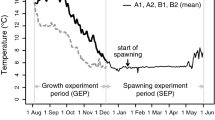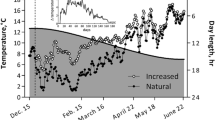Abstract
Maturing male and female Atlantic salmon (Salmo salar L.) were held under three temperature regimes for 10 weeks between September and December: warm (constant 14–16 °C), ambient (decreasing from 11 to 5 °C), and cold (decreasing from 7 to 3 °C). Blood samples were analyzed for plasma steroid levels, and the fish were inspected for the presence of expressible milt (total volume and spermatocrit) and ovulation weekly. Samples of eggs were dry-fertilized with milt stripped from three males held at the same temperatures and incubated until the eyed stage. In females, levels of plasma testosterone (T) and 17β-oestradiol (E2) dropped as ovulation approached, concurrent with a rapid increase in levels of plasma 17α,20β-dihydroxy-4-pregnen-3-one (17,20β-P). In males, levels of T and 11-ketotestosterone (11-KT) peaked 2–3 weeks after the first appearance of expressible milt, while levels of 17,20β-P increased steadily and did not exhibit a definite peak. Exposure of females to cold water amplified and advanced the profiles of all three steroids compared with the ambient group, and increased the survival rates to the eyed egg stage. Cold water had no immediate effect on the male steroid profiles, but later, higher levels of 17,20β-P were evident compared with both the ambient controls and the warm water group, while the effects on 11-KT and T were more variable. Exposure to warm water completely inhibited both milt production and ovulation. Moreover, warm water modulated the steroid profiles of the males with lower 11-KT levels compared with ambient controls and lower 17,20β-P level compared with cold-water-treated males. In females, warm water resulted in total inhibition of the peri-ovulatory peak in 17,20β-P and prevented the normal decline of T and E2 levels associated with ovulation. The findings of the present study are highly relevant for broodstock management in aquaculture, as well in understanding the impact of climate change/temperature variability on wild salmon spawning.





Similar content being viewed by others
References
Aksnes A, Gjerde B, Roald SO (1986) Biological, chemical and organoleptic changes during maturation of farmed Atlantic salmon, Salmo salar. Aquaculture 53:7–20
Chan STH, Yeung WSB (1986) A new method for the simultaneous determination of androstenedione, testosterone, 11-oxotestosterone and 11-β-OH-testosterone in fish plasma using combined techniques of celite chromatography and radioimmunoassay. J Steroid Biochem Mol Biol 25:1013–1021
Cuisset B, Pradelles P, Kime DE, Kuhn ER, Babin P, Davail S, Lemenn F (1994) Enzyme-immunoassay for 11-ketotestosterone using acetylcholinesterase as label—application to the measurement of 11-ketotestosterone in plasma of Siberian sturgeon. Comp Biochem Physiol C 108:229–241
Dahle R, Taranger GL, Karlsen Ø, Kjesbu OS, Norberg B (2003) Gonadal development and associated changes in liver size and sexual steroids during the reproductive cycle of captive male and female Atlantic cod (Gadus morhua L). Comp Biochem Physiol A 136:641–653
Davies B, Bromage N (2002) The effects of fluctuating seasonal and constant water temperatures on the photoperiodic advancement of reproduction in female rainbow trout Oncorhynchus mykiss. Aquaculture 205:183–200
Duston J, Bromage N (1988) The entrainment and gating of the endogenous circannual rhythm of reproduction in the female rainbow trout (Salmo gairdneri). J Comp Physiol A 164:259–268
Fostier A, LeGac F, Loir M (1987) Steroids in male reproduction. In: Idler DR, Crim LW, Walsh JM (eds) Proceedings of the third international symposium on the reproductive physiology of fish, St. John’s, Newfoundland, pp 239–241
Heggberget TG (1988) Timing of spawning in Norwegian Atlantic salmon (Salmo salar). Can J Fish Aquat Sci 45:845–849
Hunt SMV, Simpson TH, Wright RS (1982) Seasonal changes in the levels of 11-oxotestosterone and testosterone in the serum of male salmon, Salmo salar L, and their relationship to growth and maturation cycle. J Fish Biol 20:105–119
Hyllner SJ, Norberg B, Haux C (1994) Isolation, partial characterization, induction, and the occurrence in plasma of the major vitelline envelope proteins in the Atlantic halibut (Hippoglossus hippoglossus) during sexual maturation. Can J Fish Aquat Sci 51:1700–1707
King HR, Pankhurst NW (2000) Ovulation of Tasmanian Atlantic salmon maintained at elevated temperatures: implications of climate change for sustainable industry development. In: Norberg B, Kjesbu OS, Taranger GL, Andersson E, Stefansson SO (eds) Proceedings of the 6th international symposium on the reproductive physiology of fish, Bergen, pp 396–398
King HR, Pankhurst NW (2004a) Effect of maintenance at elevated temperatures on ovulation and luteinizing hormone releasing hormone analogue responsiveness of female Atlantic salmon (Salmo salar) in Tasmania. Aquaculture 233:583–597
King HR, Pankhurst NW (2004b) Effect of short-term temperature reduction on ovulation and LHRHa responsiveness in female Atlantic salmon (Salmo salar) maintained at elevated water temperatures. Aquaculture 238:421–436
King HR, Pankhurst NW (2007) Additive effects of advanced temperature and photoperiod regimes and LHRHa injection on ovulation in Atlantic salmon (Salmo salar). Aquaculture 273:729–738
Levavi-Sivan B, Bogerd J, Mañanós EL, Gómez A, Lareyre JJ (2010) Perspectives on fish gonadotropins and their receptors. Gen Comp Endocrinol 165:412–437
Liley NR, Breton B, Fostier A, Tan ESP (1986) Endocrine changes associated with spawning behavior and social stimuli in a wild population of rainbow trout (Salmo gairdneri) I. Males. Gen Comp Endocrinol 62:145–146
Mayer I, Berglund I, Rydevik M, Borg B, Schulz R (1990a) Plasma levels of five androgens and 17α-hydroxy-20β-dihydroprogesterone in immature and mature male Baltic salmon (Salmo salar) parr, and the effects of castration and androgen-replacement in mature parr. Can J Zool Rev Can Zool 68:263–267
Mayer I, Lundqvist H, Berglund I, Schmitz M, Schulz R, Borg B (1990b) Seasonal endocrine changes in Baltic salmon, Salmo salar, immature parr and mature male parr 1. Plasma-levels of 5 androgens, 17α-hydroxy-20β-dihydroprogesterone, and 17β-estradiol. Can J Zool Rev Can Zool 68:1360–1365
Mayer I, Schmitz M, Borg B, Schulz R (1992) Seasonal endocrine changes in male and female arctic charr (Salvelinus alpinus) 1. Plasma-levels of 3 androgens, 17α-hydroxy-20β-dihydroprogesterone, and 17β-estradiol. Can J Zool Rev Can Zool 70:37–42
Norberg B, Bjørnsson BTh, Brown CL, Deftos LJ, Wichardt UP, Haux C (1989) Changes in plasma vitellogenin, sex steroids, calcitonin and thyroid hormones related to sexual maturation in female brown trout (Salmo trutta). Gen Comp Endocrinol 75(2):316–326
Pankhurst NW, King HR (2010) Temperature and salmonid reproduction: implications for aquaculture. J Fish Biol 76:69–85
Pankhurst NW, Thomas PM (1998) Maintenance at elevated temperature delays the steroidogenic and ovulatory responsiveness of rainbow trout Oncorhynchus mykiss to luteinizing hormone releasing hormone analogue. Aquaculture 166:163–177
Pankhurst NW, Purser GJ, Van der Kraak G, Thomas PM, Forteath GNR (1996) Effect of holding temperature on ovulation, egg fertility, plasma levels of reproductive hormones and in vitro ovarian steroidogenesis in the rainbow trout Oncorhynchus mykiss. Aquaculture 146:277–290
Pavlidis M, Dimitriou D, Dessypris A (1994) Testosterone and 17β-estradiol plasma fluctuations throughout spawning period in male and female rainbow trout Oncorhynchus mykiss (Walbaum), kept under several photoperiod regimes. Ann Zool Fenn 31:319–327
Planas JV, Swanson P (1995) Maturation associated changes in the response of the salmon testis to the steroidogenic actions of gonadotropins (GtH-I and GtH-II) in-vitro. Biol Reprod 52:697–704
Planas JV, Swanson P, Dickhoff WW (1993) Regulation of testicular steroid production in vitro by gonadotropins (GTH I and GTH II). Gen Comp Endocrinol 91:8–24
Planas JV, Athos J, Goetz FW, Swanson P (2000) Regulation of ovarian steroidogenesis in vitro by follicle-stimulating hormone and luteinizing hormone during sexual maturation in salmonid fish. Biol Reprod 62:1262–1269
Rodriguez L, Begtashi I, Zanuy S, Carillo M (2000) Development and validation of an enzyme immunoassay for testosterone: effects of photoperiod on plasma testosterone levels and gonadal development in male sea bass (Dicentrachus labrax L.) at puberty. Fish Physiol Biochem 23:141–150
Rouger Y, Liley NR (1993) Effect of social environment on plasma hormones and availability of milt in spawning male rainbow trout (Oncorhynchus mykiss Walbaum). Can J Zool 71:280–285
Scott AP, Liley NR (1994) Dynamics of excretion of 17,20β-dihydroxypregn-4-en-3-one 20-sulphate, and of the glucuronides of testosterone and 17β-oestradiol, by urine of reproductively mature male and female rainbow trout (Oncorhynchus mykiss). J Fish Biol 44:117–129
Scott AP, Sumpter JP, Stacey S (2010) The role of the maturation-inducing steroid, 17,20β-dihydroxypregn-4-en-3-one, in male fishes: a review. J Fish Biol 76:183–224
Taranger GL, Hansen T (1993) Ovulation and egg survival following exposure of Atlantic salmon, Salmo salar L., broodstock to different water temperatures. Aquac Fish Manag 24:151–156
Taranger GL, Haux C, Stefansson SO, Bjornsson BTh, Walther BT, Hansen T (1998) Abrupt changes in photoperiod affect age at maturity, timing of ovulation and plasma testosterone and oestradiol-17β profiles in Atlantic salmon, Salmo salar. Aquaculture 162:85–98
Taranger GL, Stefansson SO, Oppedal F, Andersson E, Hansen T, Norberg B (2000) Photoperiod and temperature affect spawning time in Atlantic salmon (Salmo salar L.). In: Norberg B, Kjesbu OS, Taranger GL, Andersson E, Stefansson SO (eds) Proceedings of the 6th international symposium on the reproductive physiology of fish, Bergen, p 345
Taranger GL, Vikingstad E, Klenke U, Mayer I, Stefansson SO, Norberg B, Hansen T, Zohar Y, Andersson E (2003) Effects of photoperiod, temperature and GnRHa treatment on the reproductive physiology of Atlantic salmon (Salmo salar L.) broodstock. Fish Physiol Biochem 28:403–406
Taranger GL, Carrillo M, Schulz RW, Fontaine P, Zanuy S, Felip A, Weltzien FA, Dufour S, Karlsen O, Norberg B, Andersson E, Hansen T (2010) Control of puberty in farmed fish. Gen Comp Endocrinol 165:483–515
Vikingstad E, Andersson E, Norberg B, Mayer I, Klenke U, Zohar Y, Stefansson SO, Taranger GL (2008) The combined effects of temperature and GnRHa treatment on the final stages of maturation in Atlantic salmon (Salmo salar L.) females. Fish Physiol Biochem 34:289–298
Watts M, Pankhurst NW, King HR (2004) Maintenance o administration of Atlantic salmon (Salmo salar) at elevated temperature inhibits cytochrome P450 aromatase activity in isolated ovarian follicles. Gen Comp Endocrinol 135:381–390
Zohar Y, Muñoz-Cueto JA, Elizur A, Kah O (2010) Neuroendocrinology of reproduction in teleost fish. Gen Comp Endocrinol 165:438–455
Acknowledgments
The authors would like to thank the staff at the Institute of Marine Research, Matre, for their valuable assistance in the preparation and execution of the experimental work and subsequent analyses. Ms. Sissel Waage Kalvenes and Ms. Svanhild Lohne Gokstad at the Institute of Marine Research, Austevoll, are acknowledged for skillful assistance with steroid ELISAs. This study was financed by the Norwegian Research Council Grant No. 133937/122.
Author information
Authors and Affiliations
Corresponding author
Rights and permissions
About this article
Cite this article
Vikingstad, E., Andersson, E., Hansen, T.J. et al. Effects of temperature on the final stages of sexual maturation in Atlantic salmon (Salmo salar L.). Fish Physiol Biochem 42, 895–907 (2016). https://doi.org/10.1007/s10695-015-0183-1
Received:
Accepted:
Published:
Issue Date:
DOI: https://doi.org/10.1007/s10695-015-0183-1




